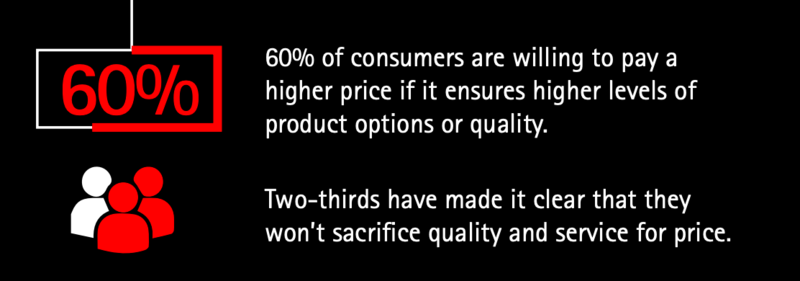Dynamic pricing means setting different prices for different customers based on customer research, market trends, and locations.
This strategy allows retailers to capture extra sales and take advantage of opportunities presented by market conditions. There’s a lot to be gained, but many companies still perceive the technology as something prohibitively expensive.
The truth is, using a dynamic pricing algorithm is available for smaller market players. Even developing a custom one is very affordable. Plus, the potential benefits are huge, so an opportunity like this is too good to miss.
In this guide:
-
Dynamic pricing definition
-
Benefits of dynamic pricing in retail
-
Fairness of Dynamic pricing
-
Dynamic pricing strategies
-
Tips for implementing dynamic pricing for retailers
What is Dynamic Pricing?
Dynamic pricing is a pricing strategy in which businesses change prices according to real-time supply and demand. It considers price changes, demand, competitors’ activity, product supply, and other factors in setting prices.
There’s powerful software behind dynamic pricing. This retail technology does thousands of calculations and checks before generating prices, so neither guesswork nor manual work is involved. A user can easily manage hundreds of thousands of checks and have a real-time view of product supply and demand.
There’s a perception that only huge retailers like Amazon can afford dynamic pricing solutions. The truth is, dynamic pricing doesn’t always require super sophisticated software that changes prices a hundred times a day. Smaller retailers can make algorithms or use existing ones.
Benefits of Dynamic Pricing in Retail
Compared to manual pricing, technology-powered dynamic pricing offers many benefits for retailers. Unlike slow-moving competitors that rely on manual pricing, technology adopters can make more money by adapting to market trends easier.
Here are the most common benefits of dynamic pricing:
-
Maximize profits, sales margins, and sales
-
Remain competitive in terms of price despite market changes
-
Quicker price optimization on a product-by-product basis
Many retailers have been successfully using dynamic pricing to increase revenues. Here are some of the most well-known ones:
-
Amazon—changes prices every 10 to 15 minutes
-
Walmart—changes prices about 50,000 a month
-
Target—changes prices store-to-store and according to location
The monetary value of a dynamic pricing engine in such large retailers is estimated at millions of dollars.
Now, let’s talk a bit about the technology behind dynamic pricing.
The Technology Behind Dynamic Pricing
Although it sounds like dynamic pricing technology is super new, its basics have been around for a long time.
Take the concept of “Happy hours” in the restaurant industry as an example. By reducing prices for specific products, diners and restaurants attract more customers. This strategy allowed them to get more revenues, so now most businesses offer “happy hours” to customers.
Now, businesses have the technology to apply the same concept outside the restaurant industry. eCommerce is an obvious choice, as businesses can track each indicator required to choose a better price (supply, competitor prices, etc.)
The dynamic pricing technology consists of an algorithm that processes numerous variables to define the final price.
These variables include:
-
Product supply (stock levels, current prices, cost predictions)
-
Product demand (traffic on competitors’ websites, product seasonality)
-
Customer data (demographics such as location, income, age, etc., devices)
-
Behavioral data (spending information, recent product research, approximate spending in the last months)
-
Prices of competitors based on the information on product pages
-
Prices of related products sold by competitors
-
Additional factors like special local events
The information about the variables often translates into thousands of thousands of data points, which is impossible for people to process. But dynamic pricing algorithms do that in a matter of minutes and generate useful insights for users.
Two major technologies are behind dynamic pricing algorithms:
Data science. This technology is responsible for dealing with huge amounts of data detecting patterns. To a data scientist, these patterns typically give ideas on price optimization. The data processing happens continuously, ensuring that a retailer’s website has the best prices.
Big data. Consists of data sets containing customer data, price data, trends, and other factors that dynamic pricing algorithms study to define prices.
The end product is a dynamic pricing engine, which also can be “trained,” or adapted, to meet the specific needs of retailers. There are five options for adapting the engine, and the best choice of them depends on each individual retailer.
The five options to add include:
-
Long-tail module—provides data for defining prices for long-tail products
-
Key value-item module—evaluates how prices affect customer behavior such as product page views and search data
-
Elasticity module—defines how price changes influence demand using factors like competitors’ tactics and product seasonality
-
Omnichannel module—ensures that prices stay consistent between online and offline channels
-
Competitive-response module—makes price recommendations based on real-time data from competitors
Major retailers are likely to use all five modules for maximum gains. But the best choice really comes down to the market nature, competitors, and customer preferences.
Is Dynamic Pricing Fair?
Yes.
The point is to find the perfect price that customers are comfortable with and the one that brings retailers maximum profits. Since that “sweet spot” changes in a matter of seconds, using software to track everything with superior accuracy makes total sense.
So, if you have a question like: “Is the goal of dynamic pricing to squeeze every dollar out of customers?” the answer is no.
In fact, research suggests that 60% of customers are ready to pay higher prices if a business provides more product options or higher quality.

So, if a retailer provides more products or better quality than competitors, setting slightly higher prices won’t be against customer expectations.
Now, let’s see how retailers can apply dynamic pricing to find that sweet price spot.
Dynamic Pricing Strategies
There are four dynamic pricing strategies that make sense for online retailers: segmented, peak, time-based, and penetration. Let’s take a close look at each one.
1. Segmented dynamic pricing
This strategy involves creating multiple product versions for different customer groups to capture as much attention as possible. A common example is a phone with different memory sizes that result in different prices.
2. Peak dynamic pricing
Retailers use peak pricing to get more revenues when competitors’ inventory is running low. They can slightly increase the prices to accompany the increase in demand. This strategy is commonly used around major holidays or special events.
3. Time-based dynamic pricing
Retailers use this strategy to adjust prices to two major indicators. First, it’s the time of day: this setting is useful to match prices to peak demands, etc. The second indicator is how long a product has been available on the market (the longer it is, the lower the price might be).
4. Penetration-oriented dynamic pricing
This strategy is used to introduce new products to a market when a retailer is unsure whether customers will like them. A common strategy is to decrease the price slightly to convince customers to try the new product.
Dynamic Pricing Tips for Retailers
Retailers are advised to follow several specific techniques to benefit from dynamic pricing engines. Let’s now review these techniques in more detail.
1. Use Customer Research to Make Decisions
Customers buy certain products with a specific frequency, which is called a purchase cycle. The length of that cycle often explains how often prices should change for products. For example, prices for clothing might change more frequently than prices for game consoles.
Such information should be considered during the development of dynamic pricing engines. Businesses should work together with data scientists to “feed” the system with data about customer expectations and market trends.
2. Match Prices with Customer Personas
A critical task in a dynamic pricing strategy is to align your target customer personas with pricing for them. Different customer groups might afford different products or product variations, so your prices should match their expectations.
For example, a high-end product version should have a higher price compared to a different one (even if that means a couple of cents). Managing these prices and versions would be key to maximizing profits.
3. Focus on the Value Proposition, not the Price
Customers look beyond product price when shopping. They check out the cost of taxes, shipping, customs duties, and other extra fees and charges they might have to pay. That’s why “too high extra costs” is the reason why almost 50% of all abandoned shopping carts happen.

Source: Baymard Institute
Your dynamic pricing strategy should also consider these extra costs when adjusting prices. The main focus should be the ultimate value proposition for the customers, which means monitoring shipping fees, offering discounts and promotions, and checking competitors’ benefits.
Dynamic Pricing: How to Get Started
Is your company considering using a dynamic pricing engine to increase profits? Then you should know that you need three basic components to get started: talent, data, and software.
The talent part means you’ll need to collaborate with data scientists and other specialists who can help create and use a dynamic pricing engine. Next, they will need to collect data both from your business and competitors to generate price recommendations. Finally, the software is the dynamic pricing engine itself.
Once you’ll get the talent and data working together, getting the dynamic pricing functionality will be a matter of time.

